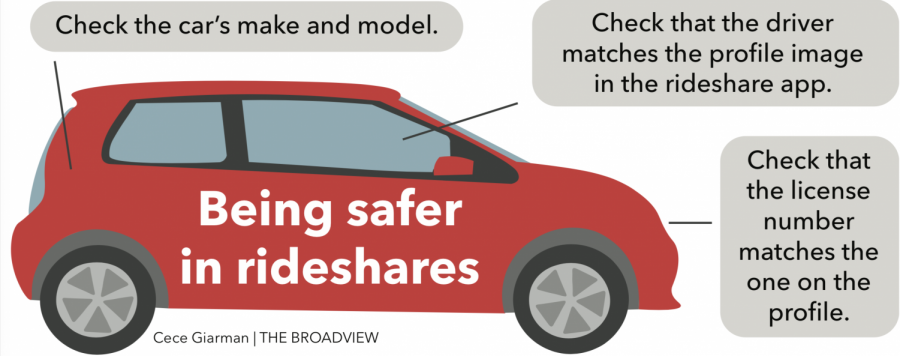Riding safely in the backseat
Rideshare companies promote user safety with in-app features
November 1, 2018
Editor’s Note: Although rideshares such as Uber and Lyft state in their company policies that riders must be 18 or older to hail a ride or ride alone, not all drivers and riders adhere to this policy. It is important that all students (especially those under 18) and parents follow company policies, as age restrictions are put in place in an effort to keep riders safe.
News stories and word-of-mouth reports of women feeling unsafe have at least half of the 29 million average daily ridesharing wondering about the safety of on-demand car services.
“My parents think that the way Uber chooses their drivers and the extent of their background checks isn’t reliable, so it’s too risky for me to Uber,” junior Maeven McShane, who does not use ridesharing services, said. “Seeing new features for safety still doesn’t cause them to let me Uber.”
McShane says Uber and Lyft have not addressed safety concerns adequately. Compared to taxi drivers, Uber and Lyft have more limited background checks and less-experienced drivers according to Michael McShane, Maeven’s father.
“The primary reason I do not let Maeven use Uber or Lyft is safety,” Michael McShane said. “We all have an app issued by the local cab company instead.”
Rideshare companies report trying to improve customer safety through updates in safety features on their mobile apps and regular public announcements about safety changes, according to an article posted on Uber Newsroom.
“Safety is our top priority, and it is our goal to make every ride safe, comfortable and reliable,” Logan Green, CEO and co-founder of Lyft, said in a statement on Lyft’s safety page. “Since the beginning, we have worked hard to design policies and features that protect our community.”
Neither Uber or Lyft would provide a representative for comment to The Broadview.
While some safety features are built into riders’ apps, such as the ability to call emergency phone numbers directly from the app, report drivers or share car location in case of emergencies, riders often personally take extra precautions, according to senior Emmy Sobol.
“I check the license plate number before I get into the car,” Sobol, who regularly rides with Lyft, said. “I also make sure they say my name before I say theirs, so I can confirm they really are the person who should be picking me up.”
Sobol says she takes the extra precautions Uber’s Rider Safety page recommends by checking the car and driver picking her up matches the information in the app and can additionally choose to share ride locations with others.
While en route, users can tap “Share status” in the app to share the driver’s name, photo, license plate, and location with a friend or family member, so they can track the user’s trip and see the estimated time of arrival without downloading the Uber app, according to Uber’s safety page.
Uber has recently added a Safety Toolkit which is home to the Safety Center, Share My Trip and 911 Assistance to make emergency aid more accessible. Lyft has also added a similar safety hub for potential emergencies which directly connects riders who believe there are in danger to 911.
“For the most part, I feel comfortable while ridesharing,” Sobol said. “I still think it’s important for everyone to be aware of the extra safety measures needed if they chose to rideshare just in case.”

